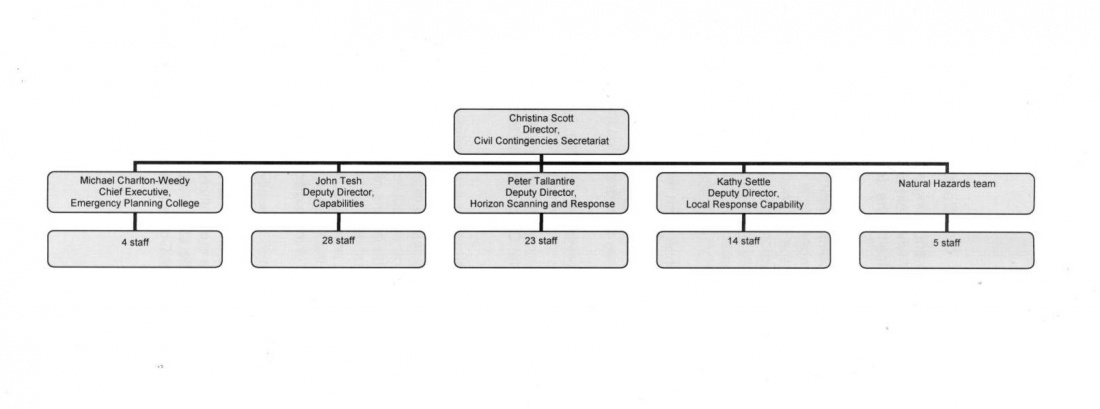Difference between revisions of "Horizon Scanning and Response Team"
| Line 1: | Line 1: | ||
| − | The [[Horizon Scanning and Response Team]] is part of the [[Civil Contingencies Secretariat]] in the [[Cabinet Office]]. It is directed by [[Peter Tallantire]] OBE who is a Deputy Director of the CCS.<ref>D Fletcher, Assistant Director, Civil Contingencies Secretariat, Cabinet Office, 'Civil Contingencies Secretariat Staff', Letter to Rizwaan Sabir, 7 April 2010</ref> | + | {{template:Counter-Terrorism badge}}The [[Horizon Scanning and Response Team]] is part of the [[Civil Contingencies Secretariat]] in the [[Cabinet Office]]. It is directed by [[Peter Tallantire]] OBE who is a Deputy Director of the CCS.<ref>D Fletcher, Assistant Director, Civil Contingencies Secretariat, Cabinet Office, 'Civil Contingencies Secretariat Staff', Letter to Rizwaan Sabir, 7 April 2010</ref> |
According to the [[Cabinet Office]] its role is as follows: | According to the [[Cabinet Office]] its role is as follows: | ||
Revision as of 08:06, 9 April 2010
Template:Counter-Terrorism badgeThe Horizon Scanning and Response Team is part of the Civil Contingencies Secretariat in the Cabinet Office. It is directed by Peter Tallantire OBE who is a Deputy Director of the CCS.[1]
According to the Cabinet Office its role is as follows:
- The role of the Horizon Scanning and Response Team is to assess circumstances that may precipitate an emergency, communicate our assessment to the key decision-makers and other parts of CCS and assist in developing an integrated response. Five specialist desks cover the full range of disruptive challenges, each with its own networks of contacts and up to the minute sources of information.
- Departments and other organisations have an interest in spotting risks that could affect their own operations. When they spot something that could potentially develop into an emergency they alert CCS. Conversely if the Horizon Scanning and Response Team picks up signals either directly or from one of its other contacts, it will share and discuss the indications with relevant partners in Government Departments and elsewhere. Together we aim to reach a view of the potential challenge that takes into account all relevant perspectives to reach an assessment of likelihood, impact and readiness.
- Written assessments will go forward to the cross-government Domestic Horizon Scanning Committee (DHSC) and once approved will be issued to senior government officials and ministers as an agreed assessment on which to base decisions and planning. The Domestic Horizon Scanning Committee may commission assessments on specific subjects.
- During emergencies there is likely to be a need to produce more regular and immediate assessments of how the emergency is developing, again taking into account the information from all relevant partners. This supports activities in COBR - the Cabinet Office Briefing Room - and the CCS Co-ordination Centre, which are designed to deliver an integrated government response.[2]
Contents
Role
The Horizon Scanning and Response Team provides an alerting service used to prioritise issues for 'simulated exercises' which 'are co-ordinated by CCS on an ongoing basis, each time based on the risk that appears to be the most likely.'[3] According to Bruce Mann, the director of the CCS:
- “That always fluctuates throughout the year; pandemic flu is always there, terrorism is always there, sometimes we’ve got water supply issues like we had last year, sometimes we have heat issues which we had a couple of years ago,” he says. “So there is always something to worry about.”
The horizon-scanning and response team, 'seeks to look at the bigger picture'. '“Just looking out for trouble,” Mann says. “They read an immense amount and they speak to a lot of people, especially on the science side, to see what is out there.”'[4]
According to Keeling:
- Once the team spot an issue they believe could be a risk to the country in the long-term or short-term future, the secretariat, key decision-makers, and a lead department when appropriate, will begin to look at how best to deal with the problem if it ever became a reality. For example, a year-and-a-half ago, when another spate of bird flu cases was reported, the CCS realised that the risk was increasing and sprung into action. This resulted in a joint Cabinet Office and Department of Health ‘flu plan’ which covers off a range of contingencies – from medical treatment to making sure essential services such as water, gas, and electricity are still up and running. And just last month, 18 months’ work from Mann and his colleagues culminated in a four-day exercise with the Department of Health which involved 8,000 people, from local authority emergency planners to ministers. “It went well,” he says. “We didn’t discover anything we hadn’t thought about.”[5]

People
See also
Notes
- ↑ D Fletcher, Assistant Director, Civil Contingencies Secretariat, Cabinet Office, 'Civil Contingencies Secretariat Staff', Letter to Rizwaan Sabir, 7 April 2010
- ↑ Cabinet Office Horizon Scanning and Response Team, accessed 6 March 2010
- ↑ Ruth Keeling, Scanning the horizon, Civil Service Live, Tuesday 1st May 2007 at 16:18, accessed 7 March 1988
- ↑ Ruth Keeling, Scanning the horizon, Civil Service Live, Tuesday 1st May 2007 at 16:18, accessed 7 March 1988
- ↑ Ruth Keeling, Scanning the horizon, Civil Service Live, Tuesday 1st May 2007 at 16:18, accessed 7 March 1988
- ↑ Cabinet Office Civil Protection News, Issue 2, Spring 2007, p. 1